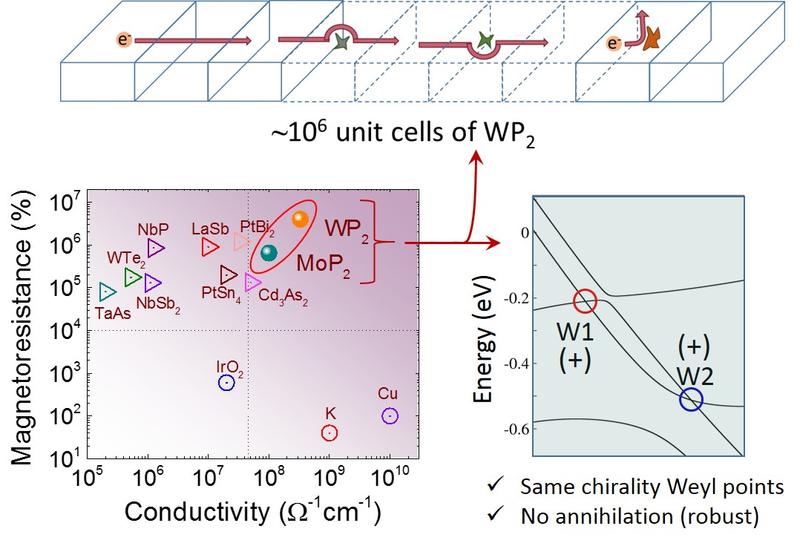

Left panel: A comparison of MR (2 K, 9 T) and conductivity (2 K, 0 T) of some well-known metals and semimetals. Metals with high conductivity have smaller MR and semimetals with smaller conductivities have larger MR. WP<sub>2</sub> and MoP<sub>2</sub> exhibit both very large conductivity as well as extremely high MR together. Right panel: The neighbouring Weyl points W1 and W2 in WP<sub>2</sub> and MoP<sub>2</sub> are of the same chirality making their annihilation with each other improbable. Upper panel: Schematic of the effect of hydrodynamics on carrier scattering.
© MPI CPfS / Nitesh Kumar
In a recent study, scientists from the Max Planck Institute for Chemical Physics of Solids in Dresden, in collaboration with High Field Magnet Laboratory (HFML-EMFL), Netherlands; Dresden High Magnetic Field Laboratory (HLD-EMFL) and Paul Scherrer Institute, Switzerland show extremely large conductivity in a semimetal, WP2.
The conductivity of ~ 3 x 108 W-1cm-1in WP2 at 2 K is comparable to highly conducting metals like potassium and copper of the similar purity.
The authors identified two major reasons for diminished scattering events in WP2 and the sister compound MoP2. First, these compounds contain robust Weyl points (difficult to annihilate), which means that backscattering events of charge carriers are less possible compared to conventional metals.
Second, the hydrodynamic effect at low temperatures ensures that the charge carriers are invisible to certain lattice defects and pass through them without getting scattered because they travel rather like a fluid.
The consequence in WP2 is a very large carrier mobility (4 x 106 cm2/Vs) and spectacular sub-millimetre mean free path (~ 106 unit cells of WP2). The mean free path is the average distance an electron can travel without getting scattered.
Because of the semimetallic nature of WP2 and MoP2, number of electrons and holes are almost equal, which additionally provide for a highly sensitive resistivity (or conductivity) towards the applied magnetic field which is otherwise not possible in a conventional metal with a single type of carriers.
Hence, we observe a record breaking conductivity and magnetoresistance (change in resistivity, 200 million % at 63 T field) present together in a compound, WP2.
The research at the Max Planck Institute for Chemical Physics of Solids (MPI CPfS) in Dresden aims to discover and understand new materials with unusual properties.
In close cooperation, chemists and physicists (including chemists working on synthesis, experimentalists and theoreticians) use the most modern tools and methods to examine how the chemical composition and arrangement of atoms, as well as external forces, affect the magnetic, electronic and chemical properties of the compounds.
New quantum materials, physical phenomena and materials for energy conversion are the result of this interdisciplinary collaboration.
The MPI CPfS (www.cpfs.mpg.de) is part of the Max Planck Society and was founded in 1995 in Dresden. It consists of around 280 employees, of which about 180 are scientists, including 70 doctoral students.












